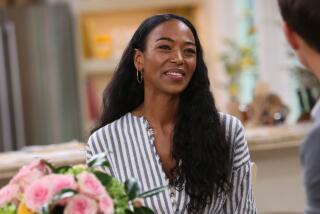A Family Crusade : She Survived Breast Cancer, Her Sister Didnât; Now Nancy Brinker Is Fighting to Save Others
Nancy Brinker was remembering Susan, the older sister who lost a three-year battle with breast cancer: âMy sister, who taught me how to put on makeup, also taught me how to die.â
She says, âWhen Suzie was dying, we made a commitment to one another. Sheâd never say âwhen I die.â Sheâd always say âwhen I get wellâ but we both knew what that meant. She said, âI donât want other women to go through what I went through.â â
Susan Goodman Komen, fashion model and mother of two, died in 1980. She was 36. Two years later, Nancy Goodman Brinker founded the Susan G. Komen Foundation For The Advancement of Breast Cancer Research. âThere were just the two of us (siblings),â Brinker explains, âand she also happened to be my best friend.â
A Difficult Time
The final months of her sisterâs illness and the months that followed were rough for Brinker. There were the pressures of launching the foundation, job worries, a divorce and custody battle over her only child. But her marriage in 1981 to Dallas businessman Norman Brinker after a whirlwind three-week courtship was a good one, and, as time passed, she was feeling âsettled and happy.â
Then, in 1984, she recalls, âI was getting in bed one night and I put my hands under the sheets and ran over this hard little lump (in her left breast). I jumped a mile.â
Nancy Brinker had had three benign breast lumps and she tried to reassure herself this was just another. But her doctorâs diagnosis confirmed her worst fears: cancer. She was 37. âI sobbed,â she says. âItâs like someone stabbed you with a knife.â
Then came âall those flashback scenes,â every vivid detail of her sisterâs âvery long and painful struggle with breast cancer. I thought that I was going to die.â
For Norman Brinker, it also was the rerun of a nightmare. His first wife, tennis great Maureen (Little Mo) Connolly, died of ovarian cancer in 1969, three years after the disease had been diagnosed. She was 34 and left two young daughters.
Today, five years since her diagnosis, Nancy Brinkerâs doctors tell her she has no signs of the disease. But with cancer, she says, âYou just pray. You never know.â She still suffers from attacks of the âcheckup crazies.â
Brinker underwent a modified radical mastectomy, followed by chemotherapy that made her fatigued, occasionally nauseated and, she says matter-of-factly, âI was bald as a bowling ball.â
No âPiece of Cakeâ
Still, she can laugh and say, âPeople always say, âWasnât chemotherapy terrible?â It wasnât a piece of cake, but divorce was worse.â
And she had an immediate goal, to play in a polo match that summer. Both Brinkers are avid polo players--he was a member of the 1952 U.S. Olympic equestrian team and founded the Willow Bend Polo and Hunt Club in Dallas. In August, 1985, one month after completing chemotherapy, she did play and recalls, âWe won the game. To my embarrassment, my mother showed up on the field with a little oxygen tank.â
Nancy Brinker since has undergone reconstructive breast surgery, as well as a preventive hysterectomy. A stunningly good looking woman, she has black hair, now grown back thick, pulled back in a chignon. Eschewing vanity, she wears bold red horn-rimmed glasses. She is 5-feet-10 and slender with a chic honed in four years as an executive trainee and assistant buyer with Neiman Marcus.
She has no patience with âwomen who whineâ and, besides, she has no time for that sort of self-indulgence.
Last Saturday in Los Angeles, after speaking at a conference on diet and breast cancer sponsored by the Nathan Pritikin Research Foundation, she did an interview while packing for a weekend in Santa Barbara with her husband. âThe first day Iâve had off in three years,â she says.
She routinely logs 120,000 air miles a year. Later this week sheâll be off to New York to do a segment for Phil Donahue on women and crisis.
Brinker is perennially named to âbest-dressedâ lists in Dallas and to committees for the right black-tie events. Norman Brinker, a self-made millionaire who stables strings of polo ponies in Dallas and Palm Beach, is chairman of Chiliâs, a Dallas-based chain with 200 restaurants nationwide, and former president of Pillsburyâs restaurant group, which includes Burger King.
Not a Socialite
âWonderful Norman,â she calls him, shaking her head as she thinks about âthat terrible thing that happened to Maureen.â She does not identify with being a socialite. She would rather tell about being appointed in 1986 to the Presidentâs National Cancer Advisory Board, one of only six lay persons on the 18-member panel.
At home, she typically puts in an eight-hour day as founder-chairwoman of the foundation, which has a paid staff of only two at national headquarters in Dallas but a group of 1,700 women volunteers who know whom to ask for money. The ultimate power lunch may be the annual fall fund-raiser at which the foundation presents its Betty Ford Award to an individual who has increased public awareness and understanding of breast cancer. Last yearâs event, honoring Nancy Reagan, drew 2,200, including former First Ladies Ford and Lady Bird Johnson.
Seven years after its founding, the Komen Foundation has raised $6 million to fight breast cancer, operates seven screening centers in four cities, has satellite groups in San Francisco, Sioux Falls, S.D., Peoria, Ill. and New York and supports 22 national research projects.
In 1987, the foundation was responsible for pushing through the Texas legislature a bill requiring third-party insurers to pay for breast cancer screening tests for women 35 and over; nine other states, including California, have since followed suit.
Brinker is driven by one goal. She says, âI donât want other women to suffer the way my sister did.â
A brochure introducing the foundation, the only national group of its kind focusing on breast cancer, offers a startling summary: âDuring the 10-year Vietnam War, 57,000 men died in combat. During the same 10-year period, 330,000 women died of breast cancer.â
Brinker knows the statistics well, and they are dismaying. In 1960, one in 13 American women contracted the disease; it is one in 10 today. In speeches, she tells audiences, âLook to your right, look to your left. One in 10 . . . â
Each year, 40,000 women in the United States die of breast cancer, one every 13 minutes, most victims of a disease that was well-advanced before detection. With early detection, before the cancer has spread to the lymph nodes, a woman has a 93% chance of surviving disease-free for 20 years.
Komenâs treatment had been, she is convinced, âa botch-up.â She speaks of the âfour wrongsâ of that case--âthe wrong city (Peoria, Ill., where Komen lived); the wrong doctor, who did not really want her to seek a second opinion; inappropriate treatment; and, on her part, wrong attitude.â
âShe Was Petrifiedâ
Brinker remembers that, when she and Komen were children, they had visited a great aunt in New York. The aunt had had a radical mastectomy and, Brinker says, âSuzie saw her undressed. She always carried that burning image in her mind. And she was petrified of having a mastectomy.â
She had the mastectomy but with neither follow-up radiation nor chemotherapy. Only 10 days after the surgery, she had a breast implant, which Brinker says was âtotally inappropriate.â Only after the disease had spread was radiation tried.
By the time she died, Komen had endured nine surgeries and three courses of chemotherapy and radiation.
Her mission, Brinker says, is to âempowerâ women who develop breast cancer, to teach them what questions to ask and how to understand the answers.
In her view, weapons in that fight include diet and life style changes, regular exercise, fewer fatty foods, as well as regular checkups, including monthly self-examination of the breasts, and, after age 35, screening by mammography. In Dallas, the foundation has made mammography available to indigent women.
A Stress Factor
She is convinced, too, that stress plays a role. When she was going through her personal crises, she says, âI honestly think my immune system went somewhere on a handcartâ and she became vulnerable to cancer.
âRace for the Cure,â the foundationâs all-womenâs 5-K run each year in Dallas, attracts 2,500 participants. Now, Brinker is writing a book, to be published by Simon & Schuster and tentatively titled âMy Race for the Cure.â She says, âItâs a story about sisters and daughters and mothers. And a very personal story about my struggle with breast cancer.â
Beyond that, she says, she wants the book, sales of which will benefit the foundation, to teach a woman stricken with breast cancer âto be an assertive, good consumer,â one who can assemble a team--surgeon, oncologist, radiologist--âand have the three of them sit down with her in a roomâ and discuss options.
âThereâs so much fear out there,â she says. She wants women to be armed with coping strategies. Among hers: Get your hair cut very short the day before starting chemotherapy. âWhen it starts to fall out, pull it out. I donât think anybody should wake up and find their hair on the pillow.â And fight back in every way possible. âMy friends who are fighters do better.â
Nancy Brinker comes by her activism genetically. In Peoria, where she and her sister grew up in a big frame house with a front porch, her grandmother started the Red Cross chapter and her mother was president of the Girl Scouts. She recalls her mother telling her, âYouâll never get anything done sitting on your duff.â
After graduation from the University of Illinois in 1968, Brinker decided to go West, to Dallas. Before her marriage to Brinker, she was a radio and television reporter and talk show host there.
Today, the foundation is her job. In 1987, it expanded its scope with creation of the Susan G. Komen Alliance for Breast Cancer Research, Education and Treatment, a triumvirate that includes the foundation, the University of Texas Southwestern Medical Center in Dallas and Baylor University Medical Center.
The allianceâs goal is a national network of researchers, specialists and treatment facilities.
Nationally, the foundation has funded research at Johns Hopkins in Baltimore, the National Cancer Institute at Bethesda, Md., the Peralta Cancer Research Institute in Oakland and the M. D. Anderson Cancer Center in Houston.
She does not expect a cure for breast cancer in her lifetime. But she thinks that cutting the mortality rate in half by the year 2000 is possible.
Sometimes, she admits, âIâve had enough (of) cancer,â sometimes she would like turn the work over to others. But then she will hear of someone else who has been diagnosed with the disease. âI just canât tell you how many friends Iâve lost,â she says. âI just canât tell you.â


